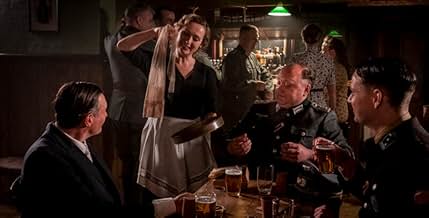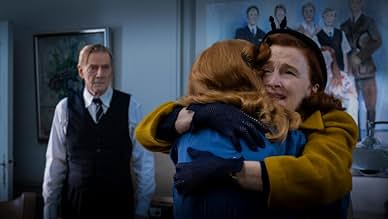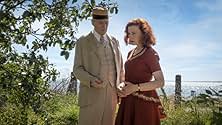Fuerte y dramática secuela de "En la oscuridad", que sigue a la familia Skov desde 1943 hasta el final de la Segunda Guerra Mundial. La creciente oposición a la ocupación y la creciente brut... Leer todoFuerte y dramática secuela de "En la oscuridad", que sigue a la familia Skov desde 1943 hasta el final de la Segunda Guerra Mundial. La creciente oposición a la ocupación y la creciente brutalidad de los alemanes.Fuerte y dramática secuela de "En la oscuridad", que sigue a la familia Skov desde 1943 hasta el final de la Segunda Guerra Mundial. La creciente oposición a la ocupación y la creciente brutalidad de los alemanes.
- Dirección
- Guionistas
- Elenco
- Premios
- 2 nominaciones en total
- Dirección
- Guionistas
- Todo el elenco y el equipo
- Producción, taquilla y más en IMDbPro
Opiniones destacadas
The film stands as a visually compelling and ambitious portrayal of Denmark during the final years of World War II, focusing on the complexities of occupation, resistance, and collaboration. Director Anders Refn delivers a narrative that attempts to encapsulate the multifaceted experiences of a nation under duress, using the microcosm of a single family's journey to reflect broader societal tensions.
Cinematographically, the film excels in capturing the stark contrasts of the era-from the subdued interiors of Danish homes to the tension-filled streets under curfew. The attention to period detail in set design and costumes enhances the authenticity, immersing the audience in the 1940s setting. However, some scenes suffer from low lighting, making it challenging to discern the action, which may detract from the viewing experience.
Performances are a standout, particularly from the lead actors who convey the internal and external conflicts faced by their characters. The portrayal of moral ambiguity is central, as characters navigate the blurred lines between survival and betrayal. This nuanced depiction challenges the often black-and-white narratives of wartime cinema, offering a more complex view of human behavior under duress.
However, the film's ambition to encapsulate the entirety of Denmark's wartime experience through a single family's story leads to a densely packed narrative. The multitude of subplots-ranging from resistance activities to personal relationships-can at times overwhelm the central storyline, potentially diluting the emotional impact. Some sequences, while well-executed, may benefit from a more focused approach to maintain narrative cohesion.
In comparison to other World War II dramas that explore similar themes, this film distinguishes itself by delving into the less-explored aspects of Denmark's history, such as the role of the Danish police as collaborators and the complexities of the resistance movement. This perspective provides a fresh lens through which to examine the moral dilemmas faced by individuals during the occupation.
While the film's scope is ambitious, and its execution largely successful, the dense narrative and multitude of characters may challenge viewers seeking a more streamlined story. Nevertheless, its commitment to portraying the multifaceted nature of wartime experiences makes it a significant contribution to the genre, offering a thought-provoking exploration of a nation's struggle with its past.
Cinematographically, the film excels in capturing the stark contrasts of the era-from the subdued interiors of Danish homes to the tension-filled streets under curfew. The attention to period detail in set design and costumes enhances the authenticity, immersing the audience in the 1940s setting. However, some scenes suffer from low lighting, making it challenging to discern the action, which may detract from the viewing experience.
Performances are a standout, particularly from the lead actors who convey the internal and external conflicts faced by their characters. The portrayal of moral ambiguity is central, as characters navigate the blurred lines between survival and betrayal. This nuanced depiction challenges the often black-and-white narratives of wartime cinema, offering a more complex view of human behavior under duress.
However, the film's ambition to encapsulate the entirety of Denmark's wartime experience through a single family's story leads to a densely packed narrative. The multitude of subplots-ranging from resistance activities to personal relationships-can at times overwhelm the central storyline, potentially diluting the emotional impact. Some sequences, while well-executed, may benefit from a more focused approach to maintain narrative cohesion.
In comparison to other World War II dramas that explore similar themes, this film distinguishes itself by delving into the less-explored aspects of Denmark's history, such as the role of the Danish police as collaborators and the complexities of the resistance movement. This perspective provides a fresh lens through which to examine the moral dilemmas faced by individuals during the occupation.
While the film's scope is ambitious, and its execution largely successful, the dense narrative and multitude of characters may challenge viewers seeking a more streamlined story. Nevertheless, its commitment to portraying the multifaceted nature of wartime experiences makes it a significant contribution to the genre, offering a thought-provoking exploration of a nation's struggle with its past.
I prefer when movies don't insult my intelligence. In this character-driven world war two drama, many things are only implied, which is great. An example: in a short scene a mother and her son want to escape by boat from Denmark to neutral Sweden. We are not told why and we don't know anything about them, but if you know your history, you will be able to fill in the blanks.
But this also presents a dilemma. Not only is this movie the second part of a family saga, so you need to watch the first one in order to get a grasp about what is going on and the who's who. But if you don't know anything about the years of the nazi occupation in Denmark, this could be a tough watch.
By far the strongest points are the moral conflicts and dilemmas that all the characters face. Who can you trust? Where is your loyality? Great stuff here.
But this also presents a dilemma. Not only is this movie the second part of a family saga, so you need to watch the first one in order to get a grasp about what is going on and the who's who. But if you don't know anything about the years of the nazi occupation in Denmark, this could be a tough watch.
By far the strongest points are the moral conflicts and dilemmas that all the characters face. Who can you trust? Where is your loyality? Great stuff here.
Out of The Darkness is the second chapter to Into the Darkness the story of a Danish family living under German occupation in WWII. I thought the first film was "okay" kind of a long, slow WWII soap opera of a well off family adapting to wartime conditions. Jesper Christensen is the family patriarch who guides his family and grown children through the huge upheaval of the war. This follow up film shows the outcome of the choices family members make in response to occupation, some choosing to join the Nazis, some joining the resistance. In the end it's a satisfying telling of WWII from the Danish perspective but deeply personalized seeing it through the journey of one family.
De Forbandede År 2 is a Danish film directed by Anders Refn, which explores the various aspects of the occupation of Denmark during World War II. The film is a follow-up to the previous installment, De Forbandede År, and picks up in 1943, focusing on the Skov family, a wealthy Danish family deeply divided and confused. The film follows the family as they navigate the various challenges and complexities of the occupation, including collaboration with the Germans, resistance movements, and the impact of the war on Danish society.
The film offers an interesting follow-up to the characters introduced in the previous installment, exploring how their internal emotions change and how the oppressors become oppressed. The film is a nice bookend to the series, with powerful scenes that are both beautiful and engaging. The film features excellent performances from the cast, particularly Jesper Christensen and Bodil Jørgensen as the Skov family, and Mads Reuther as the conflicted antihero Aksel.
The film also offers a nuanced portrayal of the various aspects of the occupation, including the role of the Danish police as German collaborators, the cynical logic of collaborationist policies, and the important role played by communist resistance fighters. The film is a powerful depiction of the war and its impact on Danish society, and a welcome addition to the growing wave of resistance films in Danish cinema.
The film offers an interesting follow-up to the characters introduced in the previous installment, exploring how their internal emotions change and how the oppressors become oppressed. The film is a nice bookend to the series, with powerful scenes that are both beautiful and engaging. The film features excellent performances from the cast, particularly Jesper Christensen and Bodil Jørgensen as the Skov family, and Mads Reuther as the conflicted antihero Aksel.
The film also offers a nuanced portrayal of the various aspects of the occupation, including the role of the Danish police as German collaborators, the cynical logic of collaborationist policies, and the important role played by communist resistance fighters. The film is a powerful depiction of the war and its impact on Danish society, and a welcome addition to the growing wave of resistance films in Danish cinema.
¿Sabías que…?
- TriviaIn Memoriam: Flemming Quist Møller (1942-2022)
- ConexionesFollows De forbandede år (2020)
Selecciones populares
Inicia sesión para calificar y agrega a la lista de videos para obtener recomendaciones personalizadas
- How long is Out of the Darkness?Con tecnología de Alexa
Detalles
- Tiempo de ejecución2 horas 32 minutos
- Color
Contribuir a esta página
Sugiere una edición o agrega el contenido que falta

Principales brechas de datos
What is the French language plot outline for De forbandede år 2 (2022)?
Responda































